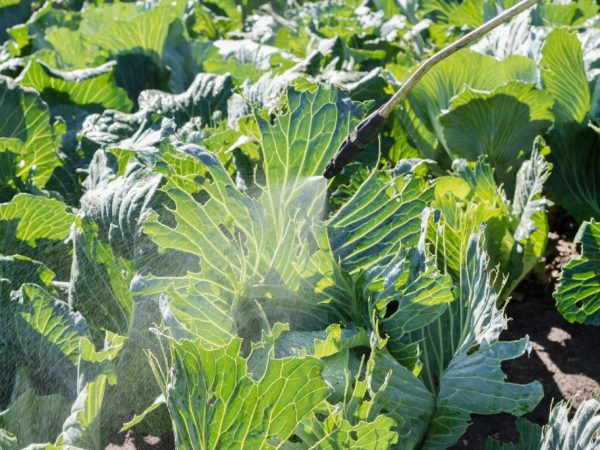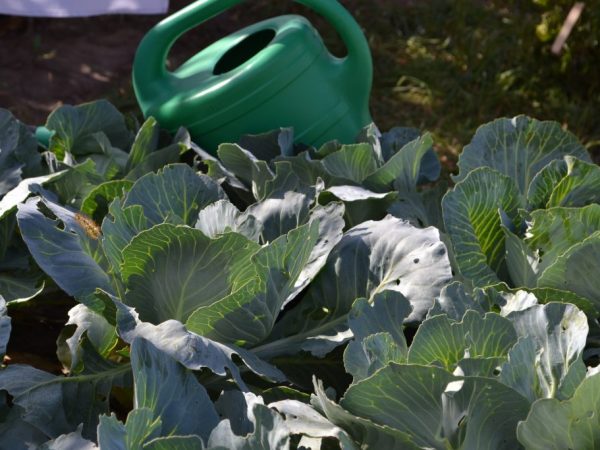Spraying cabbage with valerian
Sometimes, in the process of growing cabbage, traditional methods of pest control are preferred to chemicals. Such an environmentally friendly method for vegetables is spraying cabbage with valerian.

Spraying cabbage with valerian
For what pests is valerian dangerous?
Using valerian for cabbage can save vegetables from damage by certain pests.
Leaf beetle
Among the people, the leaf beetle is also called "babanukha". This harmful insect of small size, black with green metallic wings and brown legs, gnaws holes in the cabbage leaves, laying eggs on the surface of the leaf blades. The hatched larvae damage most of the cabbage plantings, so gardeners try to get rid of this insect as quickly as possible and often use valerian in the fight against it.
Barid
Green baride does not tolerate the smell of valerian. This insect is easily recognizable by its rich blue-green metallic sheen and furrowed wings. After its appearance on cabbage plantings, the leaves turn yellow and are covered with small growths.
Cabbage fly
Spring and summer cabbage flies are a real threat to vegetables. Outwardly similar to the common variety, they actively reproduce with the arrival of the first heat, laying off larvae that feed on the cabbage harvest. Spraying plants with solutions with valerian discourages flies from growing vegetables.
Whitefly
Another pest against which it is advised to spray the plantings of cabbage with valerian is the whitefly butterfly. Like flies, its larvae feed on cabbage leaves and harm vegetables.
Effectiveness of Valerian with Soap
Pharmacy valerian tincture, mixed with a small amount of soap, is considered one of the most effective remedies against cabbage pests. To prepare a working fluid for spraying, 1 bottle of tincture (25 g) is required at the rate of 3 liters of water and no more than 2 tbsp. l. soap.
Any soap that enhances the effectiveness of adhesion of the solution to cabbage leaves can be used. Especially popular is the alkaline household one.

The solution can be used to water plants
All components are thoroughly mixed in water. Cabbage plantings are sprayed with the prepared working solution. Treatment acts as a preventive measure and is a method of plant treatment.
After rain, it is required to re-treat the plants with a soapy solution with valerian.
The alternation of spraying of cabbage with treatment with ammonia helps to increase the effectiveness of valerian's action on pests. 1 bottle (25 g) of ammonia is diluted in 5 liters of water and 2 tbsp. l. soap. Such solutions can be used to process plantings or use them for watering plants.
Pure juice formulations
Fresh valerian juice, which is used to treat cabbage plantings against pests, has no less effective effect.The juice is squeezed out of plants by rolling in a meat grinder or grinding in a blender. The resulting mass is squeezed through a gauze cloth, poured into a clean container and placed in a refrigerator.
The shelf life of pure valerian juice, suitable for processing cabbage plantings, is up to 1 month.
Cabbage plantings are sprayed with a freshly prepared working solution of 10 drops of pure valerian juice and 10 liters of pesticide formulations.
Decoctions with valerian and tobacco
Valerian decoctions, into which tobacco is mixed, allow you to quickly get rid of the invasion of pests on cabbage. For such broths, you need:
- 5 l of water,
- 0.5 kg of fresh tobacco leaves,
- 0.2 kg fresh valerian roots.
All components are poured with water and put on a slow fire, brought to a boil and, after boiling, immediately removed from the stove. The broth is allowed to settle in a darkened place for a day, the next day they are sprayed with cabbage plantings.
How to use valerian correctly
All solutions and decoctions based on valerian are used on cabbage in dry weather. Processing is carried out until the complete disappearance of pests on cabbage plantings, but at least 2 times a week.
For more effective control of cabbage pests, medicinal valerian bushes are additionally planted in the aisles in the beds where the vegetable crop is grown.
For prevention purposes, nearby vegetable beds are also treated, for which valerian is not dangerous.


